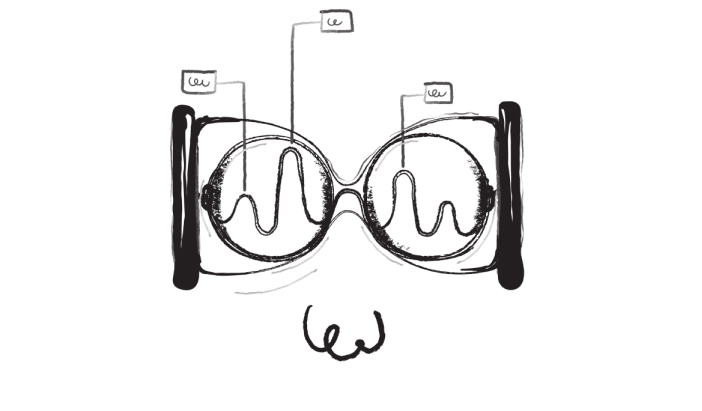
Innovation and the role of UX research.
Nowadays, innovation is a must for companies that want to keep up with their competitors. Innovation is a hot topic: a great deal has already been said and written about it, and about ways to stimulate and structure innovation within companies. But what role can UX research play in the innovation process? That depends on which approach you want to use to innovate. Depending on the choice you make, UX research plays a different role in the innovation process.
Outside-in and inside-out
Two well-known ways of thinking about innovation are the 'outside-in' and the 'inside-out' approaches. These approaches are opposite: 'inside-out' innovation assumes that the strength of a company lies in the expertise present within the company, and in the ideas that live internally in the company. In this view, innovation can be summarized as the practice of bringing ideas that originated internally to the outside world. The 'outside-in' approach is the opposite: this approach assumes that the key to innovation lies in processing customer insights, questions and experiences. The innovative ideas originate outside the company itself, are brought in, and are processed into new products or services.
The first approach, the 'inside-out' approach, is based on the strength of a company’s own people and ideas. It’s also the approach that is dominant in companies with a strong focus on design, or with visionary designers like Steve Jobs at Apple, who famously said that people don't know what they want until you show it to them. The equally famous quote about faster horses attributed to Henry Ford takes that same inside-out approach. If you asked people in the late 18th century how transportation could be improved, you might get the answer that faster horses can solve the problem. The solution developed within the company - the car - ultimately proved to be the successful solution. In brief: the inside-out approach. The second approach, on the other hand, is based on ideas that come from outside: customer needs, and the difficulties customers experience are useful sources of inspiration for innovative products and services. This idea is the basis of theories and processes such as human-centered design, design thinking, and 'open user innovation', a theory that originated in market research, and was elaborated by Eric Von Hippel.

In conversations about the value of UX research, the two approaches outlined above often come up. On the one hand, there are people who rely on input from users and customers, while other people tend to agree with Steve Jobs, and rely on the company's own strengths. But which of these approaches is the most successful one? And what is the role of UX research in these different approaches?
At first glance, only the outside-in approach seems to have a clear focus on 'customer centricity', customers and the customer experience. However, UX research also has an important added value in the inside-out approach. The difference is in the moment at which UX research is incorporated into the process, and the way it is used.
Outside-in: UX research as a source of insight and innovation
The outside-in approach is the clearest one, as far as UX research is concerned. The process starts out with exploratory research, and you learn how customers currently interact with your product. You see which issues they encounter, and how they currently experience your product. This offers you the necessary insights to either improve existing products, or process customer insights into new products. In this way, UX research is immediately present from the start of the design cycle.
Interviews with existing customers or potential customers, and observations of how current customers perform their tasks generate important new insights. Some customers might use your product in unexpected ways, or encounter issues that can be resolved with an improved product, or with a different product offering. Exploratory research allows you to detect these opportunities, as long as you bring an open mind, and the right research methods.

A specific method that focuses on outside-in innovation is open user innovation. Open user innovation focuses on 'lead users' as interesting customers to include in exploratory research. These are customers that have a strong emphasis on innovation themselves. Research has shown that those innovative customers typically look for solutions to problems that other customers have not yet faced - precisely because they are one step ahead of other customers. Since innovations often only spread gradually, lead users can be good indicators of future customer needs. Through research with lead users, you can detect those customer needs early, and respond quickly.
In sum: in the outside-in approach, UX research takes center stage as the source of innovation. Explorative research, with a clear focus on your customers’ experiences can lead to unexpected opportunities for innovative products.
Inside-out: UX research as validation and risk management
UX research also plays an important role in the inside-out approach. Great ideas can originate within the walls of a company, but of course, those ideas still need to be developed further. In this further elaboration, UX research is an important element to shape ideas, to validate them, and to manage risks when developing them.
Eric Ries, in The Lean Startup, describes UX research in these terms. Ideas originating within the company walls often make assumptions about how customers will react to a product. Ries calls those assumptions “leap-of-faith assumptions.” There's nothing wrong with those assumptions, but it's important to understand that it's best to see these assumptions as hypotheses that should be tested. That way, you can find out whether the assumptions you start from make sense.
From that perspective, Ries describes a build-measure-learn cycle, in which ideas can grow very quickly and iteratively. The idea is developed as a Minimum Viable Product (build - in early stages of the development this can be done as a non-functional mock-up or a prototype). The MVP is then tested with potential customers (measure). In the measure stage, the hypotheses to be tested are defined in advance, and the tests are set up to formulate an answer to those specific questions. Finally, lessons are drawn from the results of the tests (learn). Roughly speaking, the test results lead to two possible conclusions. It’s possible that the tests show that the hypothesis was correct, based on which you can decide to develop and refine your MVP (which Ries calls 'persevere' - continue on the same path). The tests can also show that the hypothesis is not correct. In that case, it’s a good idea to adjust the idea and choose a different direction. Overall, however, the constant iterations of UX research in the build-measure-learn cycle ensures regular customer feedback for your product in development.

This way of using UX research is fundamentally different from both the Steve Jobs approach and the outside-in approach.
The difference with Steve Jobs becomes evident when you compare the quotes from Jobs and Ries in this article. They have a radically different view on the usefulness of customer insights in product development. For the visionary Jobs, customer insights are less useful, while for Ries, they are a source of information to validate whether assumptions about your customers are correct.
One of the key differences between inside-out and outside-in innovation is in the role of UX research. The outside-in approach emphasizes exploration at the start of the design and development process, to gather the right insights. These insights are the starting point for new products. In contrast, the inside-out approach emphasizes an intensive validation and testing cycle during the design and development process, which is necessary to validate assumptions on which the new product is based. This means that the approach to UX research is very different. In the inside-out approach, research is not the starting point for the development process, but rather a way to validate existing ideas as hypotheses, and to reduce risks during design and development.
UX research as a source of new ideas or as risk management
UX research plays an important - albeit different - role in both inside-out and outside-in approaches to innovation. In one approach, UX research ensures a continuous influx of new ideas and insights that provide input for the innovation process. In the other approach, UX research provides crucial insights to make the right decisions when developing new products and services.
In short, whatever path you take as an innovative company: UX research is always a crucial element in creating successful products.

